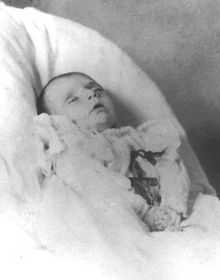Princess Cristina of Bourbon-Two Sicilies
| Princess Cristina | |||||
|---|---|---|---|---|---|
| Princess Bourbon-Two Sicilies | |||||
 Post-Mortem Photograph of Princess Cristina on her bier. | |||||
| |||||
| House | House of Bourbon-Two Sicilies | ||||
| Father | Francis II of the Two Sicilies | ||||
| Mother | Maria Sophie of Bavaria | ||||
| Born |
24 December 1869 Rome | ||||
| Died |
28 March 1870 (aged 3 mos 4 days) Rome | ||||
| Burial | Basilica of Santa Chiara, Naples | ||||
| Religion | Roman Catholic | ||||
Princess Cristina of Bourbon-Two Sicilies (full Italian name: Maria Cristina Pia Anna Isabella Natalia Elisa di Borbone delle Due Sicilie) (24 December 1869, Rome – 28 March 1870, Rome) was the only child of King Francis II of the Two Sicilies and his wife, Maria Sophie of Bavaria.
Biography
Her parents
Exiled to Rome (still under pontifical rule), the Bourbons-Two Sicilies needed to perpetuate their dying dynasty in the relatively likely scenario of a failure of the newborn (1861) Kingdom of Italy which struggled, in its early years under Savoy rule, to contain the foreign and rebellious south of the peninsula. Ever since fleeing the castle of Gaeta, where they had sought refuge, the sovereigns had looked at the current situation as a temporary one (much as it had been the case for their parents during the time of the Napoleonic empire).
Somewhat supported by other European reigning families, who had witnessed the Savoys quickly "usurp" the thrones of relatives close and distant, the Bourbons-Two Sicilies were well aware of the significance of a strong, healthy blood line to encourage former subjects to act against the Savoys—hence the pressure on Francis and Maria Sophie to conceive and procure a healthy heir designated.
However, king Francis had suffered, since birth, of a malformation that prevented him from having children. His deeply religious and shy nature also hindered any intimate contact with his wife.
Maria Sophie, after being patient for some time, finally gave free rein to her sensuality and began several extra-marital affairs. From one of her lovers, the Belgian Count Armand de Lawayss, Maria Sophie even had twins, a pregnancy kept well hidden to avoid a scandal by her mother Princess Ludovika of Bavaria and siblings.
Traveling continuously in an attempt to distract herself from a disappointing marriage, the young queen had many chances to meet new people (and new lovers) while spending time with her favourite sister, Empress Elisabeth of Austria, who regularly sought escape from her unhappy marriage as well.
After witnessing one of Maria Sophie's several liaisons, her brother-in-law, Emperor Franz Joseph I of Austria, intervened. His wife Elisabeth, unwilling to tolerate the rift between Maria Sophie and her husband any further, wrote a letter to King Francis II in which she attempted to persuade him to fulfil his conjugal duties, while calling upon her sister to return to Rome to receive a gift from her.
Francis, under pressure from the Emperor and the papal court, finally decided to undergo an operation to resolve his physical problem; Maria Sophie, upon returning to Rome, found her sister Elisabeth's gift, a beautiful and expensive double bed.
Birth and death
A deeply moved King Francis announced, in April 1869, the pregnancy of his wife. The King demonstrated his enthusiasm throughout the pregnancy, attending to his spouse and to all the preparations, including the choice of a wet nurse—a degree of involvement seldom observed in royal couples of the time. Assisted by her sister Elisabeth, who had arrived incognito for the occasion, Maria Sophie gave birth to a frail girl on Christmas Eve 1869. The infant was named Maria Cristina after her paternal grandmother, Maria Christina of Savoy.
The search for a wet nurse, which began immediately, led, after two failed attempts, to the selection of a sturdy peasant from the northern regions of the kingdom.
The choice of a governess, who effectively led the nursery, proved to be an even more arduous, and less fortunate, endeavour. The English middle-aged Lady who was finally selected turned out to be very eccentric and ill-suited to fit the Bourbon's strict royal protocol, suggesting that the infant be given cold baths and left to dry in the sun, administering alcoholic beverages "to build character", and requesting that the wet nurse do not touch the newborn altogether. As it was customary that parents rarely visite newborns (and children, in general), there was little supervision that could have prevented the infant's health from quickly deteriorating under such bizarre (and overly harsh) conditions.
An opulent baptism ceremony took place five days after the birth at Palazzo Farnese in Rome, with Pope Pius IX and her maternal aunt Elisabeth serving as godparents; the baptism was attended by much of the Neapolitan nobility, in Rome for the occasion, several diplomats, prelates, and all of Maria Sophie's sisters.
The princess' health quickly deteriorated and could not be restored. Her death, at barely three months of age, shook her parents' relationship forever: Marie Sophie left Rome, where she never returned, while Francis became even more introverted, losing interest for royal duties and dedicating his time almost completely to prayer and religious functions.
The burial occurred at the Church of Santo Spirito dei Napoletani in Rome, from which the remains were transferred, on 18 May 1984, to the Bourbon family chapel in Naples, alongside her parents'.
Titles, styles, honours and arms
Titles and styles
- 24 December 1869 – 28 March 1870: Her Royal Highness Princess Cristina of Bourbon-Two Sicilies
Ancestry
| Ancestors of Princess Cristina of Bourbon-Two Sicilies | ||||||||||||||||||||||||||||||||||||||||||||||||||||||||||||||||||||||||||||||||||||||||||||||||||||||||||||||||||||||||||||||||||||||||||||||||||||||||||||||||||||||||||||||||||||||||||||||||||||||||||||||||||||||||||||||||||||||||||||||||||||||||||||||||||||||||||||||||||||||||||||||||||||||||||||||||||||||||||||||||||||||||||||||||||||||||||||||||||||||||||||||||||||||||||||||||||||||||||||||||||||||||||||||||||||||||||||||||||||||||||||||||||||||||||||||||||||||||||||||||||||||||||||||||||||||||||||||||||
|---|---|---|---|---|---|---|---|---|---|---|---|---|---|---|---|---|---|---|---|---|---|---|---|---|---|---|---|---|---|---|---|---|---|---|---|---|---|---|---|---|---|---|---|---|---|---|---|---|---|---|---|---|---|---|---|---|---|---|---|---|---|---|---|---|---|---|---|---|---|---|---|---|---|---|---|---|---|---|---|---|---|---|---|---|---|---|---|---|---|---|---|---|---|---|---|---|---|---|---|---|---|---|---|---|---|---|---|---|---|---|---|---|---|---|---|---|---|---|---|---|---|---|---|---|---|---|---|---|---|---|---|---|---|---|---|---|---|---|---|---|---|---|---|---|---|---|---|---|---|---|---|---|---|---|---|---|---|---|---|---|---|---|---|---|---|---|---|---|---|---|---|---|---|---|---|---|---|---|---|---|---|---|---|---|---|---|---|---|---|---|---|---|---|---|---|---|---|---|---|---|---|---|---|---|---|---|---|---|---|---|---|---|---|---|---|---|---|---|---|---|---|---|---|---|---|---|---|---|---|---|---|---|---|---|---|---|---|---|---|---|---|---|---|---|---|---|---|---|---|---|---|---|---|---|---|---|---|---|---|---|---|---|---|---|---|---|---|---|---|---|---|---|---|---|---|---|---|---|---|---|---|---|---|---|---|---|---|---|---|---|---|---|---|---|---|---|---|---|---|---|---|---|---|---|---|---|---|---|---|---|---|---|---|---|---|---|---|---|---|---|---|---|---|---|---|---|---|---|---|---|---|---|---|---|---|---|---|---|---|---|---|---|---|---|---|---|---|---|---|---|---|---|---|---|---|---|---|---|---|---|---|---|---|---|---|---|---|---|---|---|---|---|---|---|---|---|---|---|---|---|---|---|---|---|---|---|---|---|---|---|---|---|---|---|---|---|---|---|---|---|---|---|---|---|---|---|---|---|---|---|---|---|---|---|---|---|---|---|---|---|---|---|---|---|---|---|---|---|---|---|---|---|---|---|---|---|---|---|---|---|---|---|---|---|---|---|---|---|---|---|---|---|---|---|---|---|---|---|---|---|---|---|---|---|---|---|---|---|---|---|---|---|---|---|---|---|---|---|---|---|---|---|---|---|---|---|---|---|---|---|---|---|---|---|---|---|---|---|---|---|---|---|---|---|---|---|---|---|---|---|---|---|---|---|
| ||||||||||||||||||||||||||||||||||||||||||||||||||||||||||||||||||||||||||||||||||||||||||||||||||||||||||||||||||||||||||||||||||||||||||||||||||||||||||||||||||||||||||||||||||||||||||||||||||||||||||||||||||||||||||||||||||||||||||||||||||||||||||||||||||||||||||||||||||||||||||||||||||||||||||||||||||||||||||||||||||||||||||||||||||||||||||||||||||||||||||||||||||||||||||||||||||||||||||||||||||||||||||||||||||||||||||||||||||||||||||||||||||||||||||||||||||||||||||||||||||||||||||||||||||||||||||||||||||